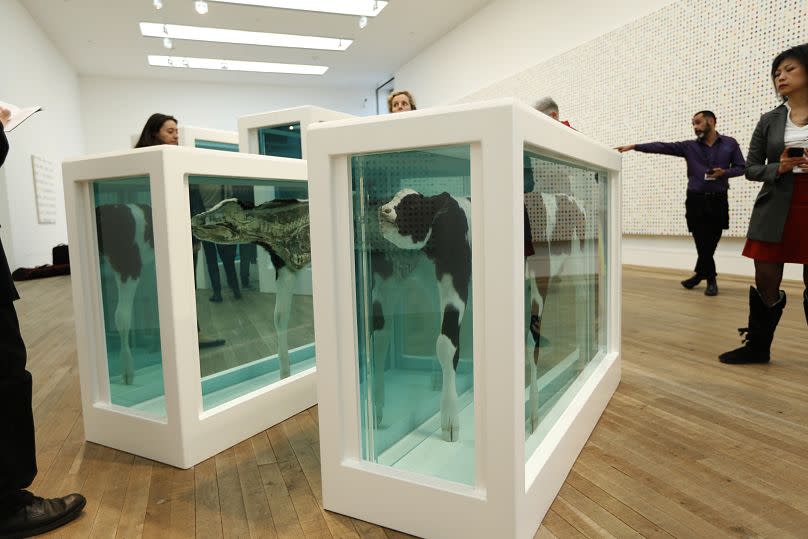Thousands of Damien Hirst artworks younger than suggested, investigation reveals

- Oops!Something went wrong.Please try again later.
British artist Damien Hirst is once again accused of falsifying the age of his artworks. An investigation by The Guardian has claimed that at least 1,000 of the 10,000 paintings used in Hirst’s 2022 project ‘The Currency’ were created at a later date than originally suggested.
In 2022, Hirst made headlines with ‘The Currency’, an experimental art project where the artist sold 10,000 of his paintings to buyers who could choose whether they would rather receive the works in physical or NFT form.
Any paintings that were bought in NFT form were then burnt at an event held in October 2022. In total, Hirst burnt 4,851 of the A4-sized paintings filled with multi-colour dots.
Damien Hirst's 1990s works actually built in 2017 claims new report
Damien Hirst is about to burn the paintings people want to keep as NFTS
“Instinctively, I have a feeling that it's not good to burn the artwork. But when I think about it, I know I have to burn the artwork because it's part of the process of what I'm doing,” the 58-year-old said at the time.
All the artworks were sold for prices starting around €2,000 and has both Hirst’s signature and the year 2016 inscribed on them. The artworks sold for around €17 million at the time by the art seller Heni which said the works were “created by hand in 2016”.
But sources, including painters working at Hirst’s company Science Ltd, have revealed to the British newspaper that at least 1,000 and possibly several thousand more were created in a period between 2018 and 2019.
The painters at Hirst’s company confirmed that they produced the works in a production line atmosphere at the award-winning artist’s two studios in Gloucestershire and London.

Each painting was given a stamp of authenticity and a date and signature.
Traditionally in the art world, the date written on a painting would signify the date of completion. Hirst’s company has denied that he has misled buyers as his “usual practice” is to date physical works by the date of its conception.
The company hasn’t responded to the Guardian’s questions about why Hirst had explicitly said the works were “made in 2016”.
Three works not from the 90s
This isn’t the first time this year that Hirst has faced allegations from the Guardian over misleadingly dating his art. In March, the newspaper found that three major artworks of his that had been suggested to be from the 90s were actually created in 2017.
Hirst’s work was exhibited in a retrospective of his 90s output at Gagosian’s Hong Kong art gallery in 2017. There, three works – ‘Cain and Abel, 1994’, ‘Dove, 1999’, and ‘Myth Explored, Explained, Exploded, 1993-1999’ – made their debut.
‘Dove, 1999’ is believed to have been sold around the time of the original Hong Kong exhibition, while the other two works have been exhibited around the world.
‘Myth Explored, Explained, Exploded, 1993-1999’ and ‘Cain and Abel, 1994’ have always been displayed consistently beside 1990s dates with the shark piece now on show at the Munich Museum of Urban and Contemporary Art.

In response to the Guardian’s questions, Hirst’s company Science Ltd said: “Formaldehyde works are conceptual artworks and the date Damien Hirst assigns to them is the date of the conception of the work. He has been clear over the years when asked what is important in conceptual art; it is not the physical making of the object or the renewal of its parts, but rather the intention and the idea behind the artwork.”
Comments from Hirst’s lawyers accepted that while many of his works are dated according to their physical creation, and despite any industry norms, that the “dating of artworks, and particularly conceptual artworks, is not controlled by any industry standard,” and “Artists are perfectly entitled to be (and often are) inconsistent in their dating of works.”

